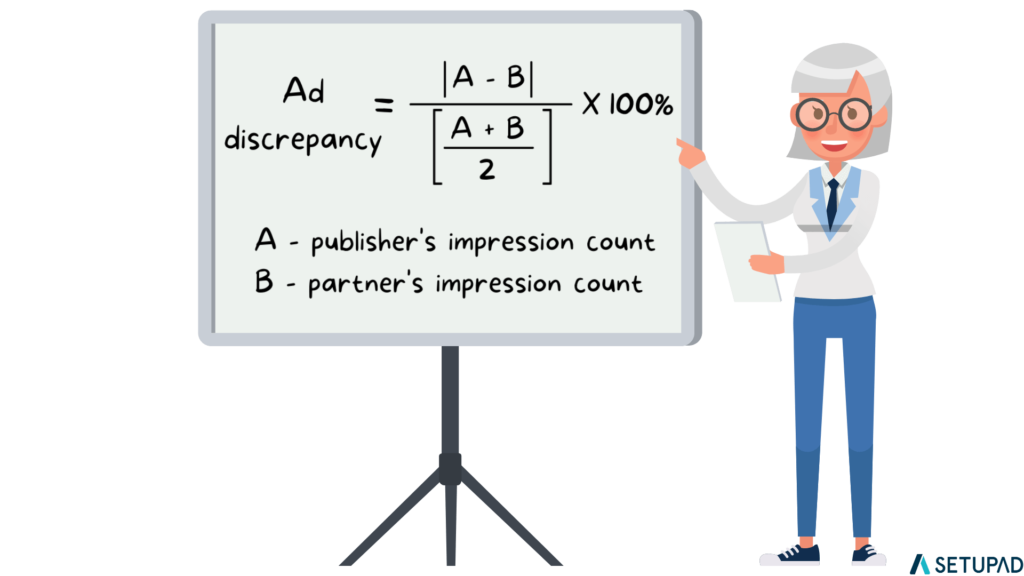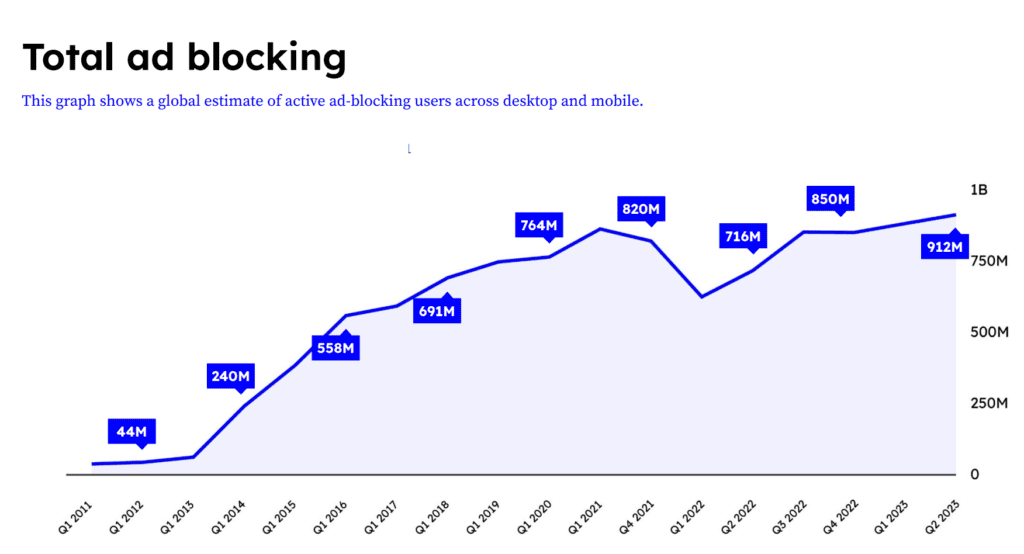What is Ad Discrepancy and How to Reduce It
You’ve probably heard about ad discrepancy or ad impression discrepancy before. If you ever look at your ad server report, you would notice that there is a mismatch (discrepancy) between your and your partner’s ad impression count.
If it’s a small difference of, say, 1-5%– there’s probably no need to worry. However, when it comes to 10% or more, it’s worth getting to the root of this problem.
Ad discrepancy can affect both ad impression and ad request count. In this article, we will mainly focus on ad impression discrepancy.
What is Ad Discrepancy?
Ad discrepancy is the inconsistency in data between two sources. It occurs because of different technology, tools, and techniques used to measure analytical data.
Ad discrepancy most commonly refers to the mismatch in the number of ad impressions between the publisher’s ad server and the demand partner’s or ad exchange’s ad server. However, it sometimes refers to the difference in ad requests between the publisher’s and the partner’s ad servers.
There are many reasons for ad impression discrepancy, but it’s often because the sell-side and the buy-side use different counting methodologies to measure ad impression data.
Ad request discrepancy happens when some ad requests are lost in an exchange between the publisher’s and the partner’s ad servers. Numerous redirects between the landing page and the ads, server timeouts, and network connection failures are the most common reasons for ad request discrepancy.
How to Calculate Discrepancy?
The formula to calculate ad discrepancy, regardless of the metric, is:
- Ad Discrepancy (%) = (Ad Server Impressions − Third-Party Impressions) / Ad Server Impressions x 100%
To calculate ad discrepancy:
- Subtract the third-party impressions from the ad server impressions.
- Take the absolute value of this difference and divide it by the ad server impressions.
- Multiply the result by 100 to get the discrepancy as a percentage.
Ad discrepancy is a measure of the difference in impressions or other metrics reported by different ad servers and can help identify potential issues with ad delivery or tracking.
Meaning–this percentage shows how much the reported impressions differ between the two sources. It doesn’t indicate which party is wrong but highlights the % of how much your number and your partner’s number differ from the true value.

There are various online calculators available on the Internet which can help you come to the same results.
Why Should Publishers Care About Ad Discrepancy?
In terms and conditions set out by Interactive Advertising Bureau (IAB), ad discrepancy below 10% is considered the norm. That’s because ad discrepancy, for the most part, cannot be totally eliminated. The reason is a complex tech infrastructure and various parties involved in tracking and reporting ad impressions.
Sometimes, ad discrepancy may occur because of inconsistencies in how different ad exchanges manage programmatic auctions. For example, the way how header bidding auction or the waterfall is implemented–through the ad server or directly added code into the publisher’s site.
In this case, ad discrepancy can be impacted by the website’s loading speed which affects the results of the programmatic auction. If the website loading speed is slow there might be a bigger ad discrepancy.
Also, a big ad discrepancy is an alert to improve your website’s loading speed and ad stack.
Related article: What is Video Header Bidding
Common Metrics Affected by Discrepancy
Ad discrepancies can impact several key metrics, with the most common ones being:
| Key metrics | How they’re affected? |
| Impressions | Discrepancies often occur in the counting of ad impressions, which represent the number of times an ad is displayed to users. Different ad servers may count impressions at varying points in the ad delivery process, leading to mismatches. |
| Clicks | Click discrepancies arise when different platforms or tracking systems report varying numbers of clicks on an ad. This can be due to differences in click attribution models or delays in tracking. |
| Conversions | Conversion discrepancies can significantly affect the assessment of campaign performance, especially when different parties use varying methods to track user actions like purchases or sign-ups after clicking on an ad. |
| Viewability | The viewability metric, which measures whether users actually saw an ad, is prone to discrepancies. Different standards for a “viewable” impression can lead to inconsistent reporting. |
The Impact of Ad Discrepancies on Revenue
Ad discrepancies can have a direct and substantial impact on revenue.
While some discrepancy is inevitable, particularly given the complex nature of digital advertising, keeping it within acceptable limits (typically under 10%) is crucial to maintaining accurate reporting, smooth financial operations, and strong business relationships.
A significant difference in reported metrics between a publisher and an advertiser can lead to underreporting or overreporting of performance. This affects how much revenue is recognized.
- For example, discrepancies can lead to disputes over billing, where advertisers may contest the amount charged based on their lower impression or click counts. This can delay payments and create friction between the involved parties.
If discrepancies result in underreported impressions or clicks, publishers might not receive full payment for the ads served. Over time, this can add up to substantial revenue loss. Large discrepancies may also signal inefficiencies in ad inventory management, potentially leading to unsold inventory or misallocation of ads.
12 Causes of Ad Discrepancy
As mentioned, there are many causes why ad discrepancy occurs. Let’s now look at some of them.
1. Latency and load times
Latency is essentially the total time a page takes to load. Low latency is critical in the programmatic auction (aka Real-Time Bidding), however, it is impossible to eliminate it fully. Moreover, other factors also influence how fast a page loads. For example, the latency of an ad server or the distance between the user and hosting server.
However, high page latency might result in unfilled impressions. If the ads load after the page content, the user might leave before ads are served. As a result, the ad request will be recorded, but no impressions will be delivered.
Moreover, if the page takes too long to load, the user might simply abandon it, resulting in high bounce rates and hurt SEO.
Related Article: 5 Proven Tips to Reduce Page Latency with Header Bidding
The Relationship Between Page Speed and Ad Delivery
In programmatic advertising, the timing of auctions is critical.
Faster page load times ensure that ads render more quickly, increasing users’ likelihood of seeing them before navigating away. Slow load times can reduce the viewability of ads, as users may scroll past ad placements before the ad is fully rendered.
This can cause discrepancies between ad requests and actual views or clicks.
How Slow Load Times Cause Discrepancies?
Slow load times contribute to ad discrepancies in the following ways:
- Ads that load too slowly may miss the opportunity to be served, particularly in competitive programmatic environments where auctions occur in milliseconds.
- Delays in ad loading can also cause issues with tracking scripts. This can create incomplete or inaccurate data and cause discrepancies between what the publisher reports and what the advertiser tracks.
- Poor user experience due to slow load times can lead to higher abandonment rates, which directly impacts the accuracy of impression counts and other key metrics.
2. Ad blockers
Data shows that in Q2 of 2023, there were 912M active ad-blocking users worldwide, which has increased by 11% from 2021. The average YoY growth of ad blocking since 2011 has been ~30%.
Ad blocker technology uses filters to block ad requests, which results in users not seeing ads. This results in ad request discrepancy between your and your partner’s ad servers. Usually, ad blockers block both–ad delivery and measurement. However, sometimes domains or advertisers can slip through the blocking system, creating ad discrepancy.
Ad blockers can seriously interfere with your report figures because they also block tracking codes which cause your analytics report and partner’s analytics report to show different values.

Source: Blockthrough
We at Setupad offer an in-house solution to recover part of ad revenue lost to ad blockers. We run non-intrusive ad formats in several placements per page in a fully transparent and user-consented way. Contact us at [email protected] or reach out to your Account Manager to find out more.
3. Impression counting differences
There are many different ways to count ad impressions. Oftentimes it comes down to technological infrastructure, i.e., how the impression-counting platform is built.
Occasionally, the issue can be that parties count a slightly different point in the delivery of an ad, so you might want to find out what impression reporting methodology your partners are using.
For example, Google’s Campaign Manager 360 (ad server) counts impressions when the creative (ad shown to the user) begins to download, while Xandr (SSP) counts an impression when it is delivered to the page and begins to render. There are also different methodologies to determine invalid impressions.
It becomes even more tricky when demand partners pull tags from third-party vendors/ad servers for the same ad placement, which results in even more discrepancies.
4. Time zone difference
Most analytics reports don’t provide real-time data but instead data for a 24h gap. So, imagine your time zone is set for UTC+02:00, whereas the demand partner’s time zone is UTC+0. That means whenever the report is generated, there will always be a two-hour gap that isn’t accounted for.
Even though the two-hour gap seems small, there could be a significant traffic decrease or increase that can create quite a big difference between your and your partner’s reports.
5. Heavy creatives
Heavy creatives can be a major reason for ad discrepancy. Unfortunately, some creatives are just heavier than others. For example, video ads are generally heavier than display ads and require extra time to load.
Imagine that you’re serving outstream video ads on your website. Now, a user comes to your site but leaves before the ad was still loading. As a result, there will be a discrepancy in the final number of impressions (video plays) served. The publisher’s ad server counted the impressions, but the ad did not have a chance to be displayed.
6. Bot traffic
Bots are special software that inflates traffic to earn money from advertisers. However, most ad servers use bot-filtering tools to check for suspicious traffic. So, if your site has been a target of bots, there’s a big chance your website will be blocked and will not be able to display ads. This is why monitoring your traffic in analytics reports and using security checks such as reCAPTCHA and robots.txt files is important.
Sometimes, the discrepancy grows during certain hours of the day, for example, during night hours. This also may be a sign of traffic quality issues.
Our team put together an ultimate guide on how to detect and avoid bot traffic, so please check it out.
Malvertising attacks can also cause ad discrepancy. For example, when the anti-malvertising software blocks the low-quality ad, it can take some time for the new ad to load, thus creating discrepancy.
7. Page caching
Page caching stores static versions of web pages to speed up load times for returning users. However, it can lead to discrepancies in ad reporting because cached pages might serve outdated ads or bypass ad requests altogether.
This can cause significant differences between the number of ad requests and actual impressions, as new ads might not be fetched each time a user revisits the page.
8. Counting methodology differences
Ad tech platforms use various methodologies to count impressions, clicks, and conversions.
- For example, some platforms count an impression when an ad is requested, while others count it when the ad is fully rendered on a user’s screen.
These variations lead to discrepancies because different parties (e.g., publishers and advertisers) may report differing metrics for the same campaign. Misalignment in counting standards, such as when impressions are logged, can result in substantial discrepancies in ad performance data.
9. Geo-targeting issues
Geo-targeting discrepancies arise when ads are served to users outside the intended geographic area due to misconfigured settings or IP detection errors.
In this case, the ads might not reach the target audience, as these inaccuracies can lead to incorrect reporting of impressions and clicks.
10. Creative errors
Creative errors occur when the ad creative fails to load properly or displays incorrectly, often due to issues like incompatible formats, broken links, or large file sizes.
Such errors can prevent the ad from being served, causing discrepancies between ad requests and actual impressions or clicks.
11. Ad refresh techniques
Ad refresh techniques involve reloading ads within the same placement after a set period or user interaction.
While this can increase impressions, it can also lead to discrepancies if not properly tracked, as some systems may not accurately count refreshed ads or may double-count them, distorting performance metrics.
12. Ad network filtering
Ad network filtering is the process where ad networks block or filter out certain ads based on quality, relevance, or compliance issues.
This can lead to discrepancies if the filtered ads are still counted in the initial ad requests but not served, causing a mismatch in reported impressions and actual ad deliveries.
How to Diagnose Ad Discrepancies?
Here are 5 steps that can help you diagnose ad discrepancies:
- Review server logs from both the publisher and advertiser sides to identify where discrepancies occur.
- Ensure that the timing of ad serving and tracking is synchronized across platforms.
- Confirm that all creatives are delivered correctly and track whether they are blocked or filtered.
- Align on counting methodologies used by different platforms to ensure consistency.
- Check geo-targeting settings to see whether caching might be causing discrepancies.
6 Tips on How to Reduce Ad Discrepancy
1. Use cache buster
Browser caching is necessary to speed up your page, so when the user who previously visited your page opens it again, it already has HTML, CSS, and JS stored on his side. However, caching can cause the user to see ads from the old version of the web browser, not the ad server. As a result, a publisher will display the ad several times, while the demand partner will only count one impression.
Cache buster informs the browser that a new version of the file is available using a unique file version identifier. As a result, instead of retrieving the old file from the cache, the browser sends a request to the origin server for the new file.
Just like for browser caching, cache buster plugins are widely available for most CMS.
2. Choose longer time intervals for different time zones
Time zone differences can cause serious inconsistencies in reports, therefore, it is important to choose longer time intervals between time zones so the difference is not that big.
If possible, you should agree on the time zone for which you and the partner will be pulling reports. You should also assess the data for the same period to get accurate results, for example, for a 30-day period.
3. Create daily reports
Consistency is key when it comes to the discrepancy. Once you know what an average discrepancy for each demand partner is, it’s much easier to notice any sudden spikes. Creating daily reports can help with that.
For example, if the discrepancy for one demand partner was usually around 7-8% and then suddenly rose to 13%, this is a signal of abnormal behavior. It is, therefore, essential to check all third-party reports (like Google Analytics) and see if anything was changed in the campaign.
4. Overcome Ad Blockers
Ad blockers prevent ads from being displayed and tracked, leading to significant discrepancies in reported data.
Use non-intrusive ad formats and employ ad recovery solutions that can detect when ads are blocked and attempt to serve alternative ads. This can help recover lost impressions and reduce discrepancies.
5. Optimize Load Times
Slow page load times can result in ads not being served before the user leaves the page, leading to discrepancies between ad requests and impressions.
Optimize your website’s performance by reducing file sizes, using a Content Delivery Network (CDN), and ensuring ads load asynchronously to minimize their impact on overall page speed.
6. Ensure Proper Tag Implementation
Incorrect or inconsistent tagging can result in data not being tracked properly, leading to discrepancies in reporting.
Regularly audit and verify that all ad tags are correctly implemented across your site. Ensure that tags are consistent with your partners’ tracking systems to reduce discrepancies.
Conclusion
As you can see, many different factors influence ad discrepancy. In many cases, ad discrepancy cannot be realistically mitigated, as it comes down to a complex tech infrastructure.
However, we always advise publishers to ensure which counting methodology is used by their partners. It should be the same third-party analytics vendors to decrease the chances of higher ad discrepancy.
FAQs
What Is Considered a Significant Ad Discrepancy?
A significant ad discrepancy is generally considered to be anything over 10%. While some level of discrepancy is normal, exceeding this threshold may indicate underlying issues that need to be addressed.
How Often Should Discrepancies Be Reviewed?
Discrepancies should be reviewed daily to catch any sudden spikes or trends that could indicate issues with ad serving, tracking, or data reporting.
What Tools Are Best for Diagnosing Ad Discrepancies?
Tools like Google Analytics, Ad Manager, and third-party verification platforms (e.g., MOAT, DoubleVerify) are effective for diagnosing ad discrepancies.
How Can I Communicate Effectively with Ad Networks About Discrepancies?
Communicate clearly and promptly, providing detailed reports and specific data points that highlight the discrepancy. Regularly engage with your account manager to ensure alignment.
What Are the Most Effective Methods for Reducing Ad Discrepancies?
Effective methods include implementing cache busters, optimizing load times, synchronizing time zones, using consistent tagging methods, and regularly updating ad creatives.


